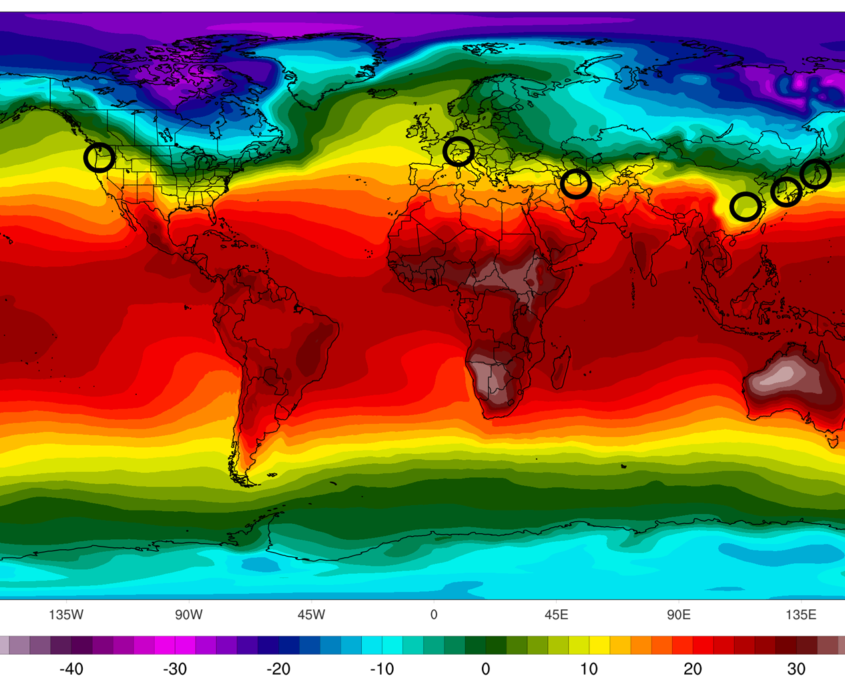ENHANCED MODEL FOR MONITORING ZONES OF INCREASED RISK OF COVID-19 SPREAD
Research By GVN Scientists Establishes Link Between Temperature, Latitude, Spread & Seasonality
Baltimore, MD, March 10, 2020: Scientists affiliated with the Global Virus Network (GVN), the worldwide coalition of preeminent virologists engaged in the preparedness, defense and first research response to emerging, existing and unidentified viruses that pose a clear and present threat to public health, have determined that temperature and latitude may have a direct link to the spread and seasonality of COVID-19. The analysis was conducted by Drs. Mohammad M. Sajadi, MD, and Anthony Amoroso, MD, in conjunction with the Institute of Human Virology at the University of Maryland and Global Virus Network. Their paper (https://bit.ly/3cMhQ43), “Temperature and Latitude Analysis to Predict Potential Spread and Seasonality for COVID-19” has been made publicly available at the Elsevier’s SSRN site (https://papers.ssrn.com/sol3/papers.cfm?abstract_id=3550308). Researchers from University of Maryland College Park, Shiraz University of Medical Sciences in Shiraz, Iran, and Shaheed Beheshti University of Medical Sciences in Tehran, Iran also participated in this study.

Figure. World 1000hPa temperature map March 2019-April 2019 showing at risk zone. Color gradient indicates 1000hPa temperatures in degrees Celsius. Tentative zone at risk for significant community spread in the near-term include land areas within the light green bands, outlined in dark black (showing 5-10°C zone based on 2019 data). Predicted area is up to 11°C (slightly more south, not shown), and will change based on actual average temperatures during this time period. Image from Climate Reanalyzer (https://ClimateReanalyzer.org), Climate Change Institute, University of Maine, USA.
“Through this extensive research, it has been determined that weather modeling could potentially explain the spread of COVID-19, making it possible to predict the regions that are most likely to be at higher risk of significant community spread in the near future,” said Robert C. Gallo, MD, Co-founder & Director, Institute of Human Virology at the University of Maryland School of Medicine and Co-Founder and Chairman of the International Scientific Leadership Board of the GVN. Dr. Gallo is also The Homer & Martha Gudelsky Distinguished Professor in Medicine and Director, Institute of Human Virology at the University of Maryland School of Medicine, a GVN Center of Excellence. “In addition to climate variables, there are multiple factors to be considered when dealing with a pandemic, such as human population densities, human factors, viral genetic evolution and pathogenesis. This work illustrates how collaborative research can contribute to understanding, mitigating and preventing infectious threats.”
To date, COVID-19, caused by SARS-CoV-2, has established significant community spread in cities and regions along a narrow east and west distribution, roughly along the 30-50 N” corridor at consistently similar weather patterns (5-11 degrees C and 47-79% humidity). The GVN’s simplified weather model illustrates the regions that are potentially at higher risk of significant community spread of COVID-19 in the coming weeks, allowing for concentration of public health efforts on surveillance and containment.
“The research conducted by Drs. Mohammad M. Sajadi, MD, and Anthony Amoroso, MD, suggests that overall, human coronaviruses (HCoV-229E, HCoV-HKU1, HCoV-NL63 and HCoV-OC43), which usually lead to common cold symptoms, have been shown to display strong winter seasonality between December and April, and are undetectable in summer months in temperate regions,” said Dr. Christian Bréchot, MD, PhD, President of the GVN, and a Professor at the University of South Florida. “Based upon the analysis, and assuming the virus doesn’t continue to mutate, we would expect that COVID-19 will diminish considerably in affected areas (above the 30-degree N”) in the coming months, however, the virus could survive at low levels in tropical regions and begin to rise again in the late fall and winter in temperate regions in the upcoming year. We will continue to monitor closely and provide real-time updates as developments and information warrant.”
“Based on what we have documented so far, it appears that the virus has a harder time spreading between people in warmer, tropical climates,” said study leader Mohammad Sajadi, MD, Associate Professor of Medicine at the IHV in UMSOM and a member of GVN. “That suggests once average temperatures rise above 12 degrees Celsius and higher (54 degree Fahrenheit and higher), the virus may be harder to transmit, but this is still a hypothesis that requires more data.”
The spread of SARS-CoV-2 has reached pandemic level, with a major impact on national health systems, economics and population behaviors. Delineating and understanding the future of the pandemic expansion and geographical areas affected has important consequences in preparation and impacting the viral dissemination. The GVN is committed to advancing knowledge about how to identify and diagnose pandemic viruses, mitigate and control how such viruses spread and make us sick, as well as to catalyze and facilitate the development of drugs, therapeutics, treatments and vaccines to combat them. For more information on the GVN, please visit: www.gvn.org.
# # #
About the Global Virus Network (GVN)
The Global Virus Network (GVN) is essential and critical in the preparedness, defense and first research response to emerging, exiting and unidentified viruses that pose a clear and present threat to public health, working in close coordination with established national and international institutions. It is a coalition comprised of eminent human and animal virologists from 53 Centers of Excellence and nine Affiliates in 32 countries worldwide, working collaboratively to train the next generation, advance knowledge about how to identify and diagnose pandemic viruses, mitigate and control how such viruses spread and make us sick, as well as develop drugs, vaccines and treatments to combat them. No single institution in the world has expertise in all viral areas other than the GVN, which brings together the finest medical virologists to leverage their individual expertise and coalesce global teams of specialists on the scientific challenges, issues and problems posed by pandemic viruses. The GVN is a non-profit 501(c)(3) organization. For more information, please visit www.gvn.org. Follow us on Twitter @GlobalVirusNews
MEDIA CONTACT
Nora Samaranayake, GVN
410-706-1966
[email protected]
